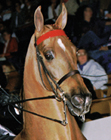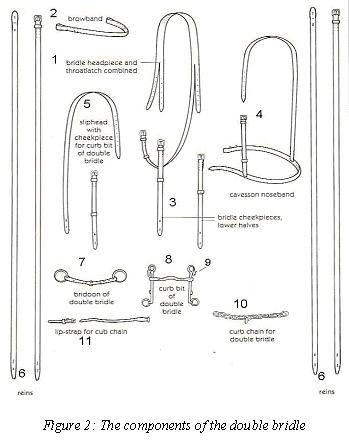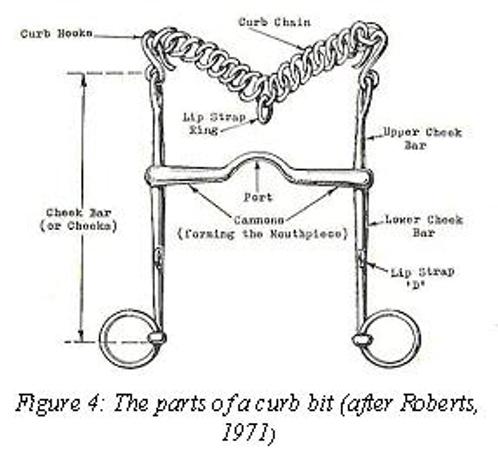|
To be an effective rider you must understand how
a full bridle is set up and what the different bits do.
What is a full bridle?

| Horse Wearing a Full Bridle |

|
A full bridle, also known as the double or weymouth bridle, consists of a snaffle and a curb bit
used simultaneously in the horse's mouth, with a set of reins to each. The curb bit and snaffle should be arranged
in the mouth so that the horse is comfortable and the snaffle lies above the curb, allowing both bits to work to their full
ability.
The full bridle allows the rider to fine tune communication with the horse. The curb is used for longitudinal
flexion (to bring the nose to chest), and requires that the horse already be in uphill carriage, since you can’t get
the horse’s head up with the curb. In laymen’s terms you use the snaffle to raise the head and neck, or the curb
to raise it and tuck the horse's nose. The rider must
already be skilled in getting the horse up in front from the seat and leg.
The two pairs of reins
are attached to the bits, one set to the snaffle and one to the ring at the bottom of the cheek or branch of the curb bit.
The two pairs of reins are often different, in that one pair will usually be either thinner than the other or will have some
sort of grip added, either rubber or leather lacing. This is so the rider can distinguish between the snaffle and curb rein.
When the reins are leather, as on a show bridle, the snaffle rein is usually slightly wider than the curb (commonly one size,
i.e. 1/8 of an inch), so it is easier to hold and encourages the rider to use mainly the snaffle action of the double bridle.

Prerequisites for effectively using a full bridle:
1. Seat
of the rider must be correct, with no reliance on the reins for balance in ALL gaits (including the extended gaits)
2. Steady
hands
3. Body/hands
remaining steady during transitions
4. Ability
to weight seat bones at will
5. Control
of the lower legs and spurs
6. Ability
to sit in the center of the horse, both side to side and front to back
7. Ability
to control the length of the reins, and to shorten/lengthen them at will
Riding with a full bridle
is like conducting an orchestra. It takes a maestro to do it well.
Common
Bits and How They Work:
Snaffle
| One type of snaffle for the double bridle |

|
A snaffle is a bit without shanks that works on the lips, tongue
and bars of the horse's mouth with only as much pressure as you, the rider, directly put on it through your contact (pull,
to be crude) on the reins. It may have a jointed or a bar mouthpiece.
The snaffle bit is
a thin bit, usually made with loose rings. It has a thin, jointed mouthpiece, and is often very light. It should be noted
that the thickness of the mouthpiece will affect the horse, as although it is (usually) a simple snaffle, being very thin
it will have a high ratio of pounds per square inch.
The
snaffle’s action is principally on the lips at the corners of the mouth, on the bars (interdental space behind the front incisors and in front of the back molars) and on the tongue. Different mouthpieces and nosebands will alter the action, but the first point of action of the
snaffle is when the head is raised against the corners of the mouth. The snaffle has an elevating effect on the head.
The most important thing to remember is that the
snaffle bit should be used 70% of the time. We use the snaffle to control the position of the neck and withers. Through the
snaffle we communicate between the hand and a mouth letting the horse to know which way to go. On the extended gaits, the
snaffle provides sufficient support. So, if the snaffle serves 70% of the hands aids, what does the curb do?
Curb

|
| Lower Cheek Bar aka Shank. Upper Cheek Bar aka Purchase. |
A curb is a bit with shanks and a chain or strap under the
jaw that acts as a fulcrum for the lever action of the bit in the horse's mouth. It puts pressure on the bars, tongue and
jaw, the amount depending on the design of the bit (longer shank -- more pressure on jaw, higher port -- more pressure on
roof of mouth) and the amount of contact you keep with the reins. It raises a horse's head and neck and can make him tuck
his nose. A curb bit can be very painful to a horse; a light pull on the reins with a long shanked curb is much more severe
than a heavy pull on the reins with a snaffle.
The
curb chain attaches to the offside (right) hook and should be twisted clockwise until the links lie flat, then hooked onto
the nearside (left) hook. The fly link (a loose link in the middle of the chain) should hang in the middle and the lip strap
is threaded through and buckled together. A common misconception is that the lip strap is only necessary for keeping the curb
chain in place, but its main function is to stop the cheek of sliding cheek curbs from inverting and rendering the curb ineffective,
or from being dragged into the horse's mouth. The curb chain, whether made single link or of multiple links, should always
lie flat. The curb chain is essential on a curb bit; otherwise the lever action is dependent entirely on the headpiece. No
curb bit has the actions of a curb unless a curb chain is used. Without a chain the bit reverts to a form of snaffle, its
severity being governed only by the design of the mouthpiece and cheeks. The chain can sometimes rub on a horse's jaw. In
these cases a rubber curb guard can be used and relieves the pressure slightly from the chin. The curb bit works on the basis
of a lever action. The mouthpiece is effectively the fulcrum (hinge), the upper and lower cheeks the lever. The length of
the branch (shaft) below the mouthpiece determines how much action the cheek (above the mouthpiece) will have on the poll,
rotating around the mouthpiece. The idea of the curb is, through pressure on the horse's poll, together with the curb chain
acting on the chin groove, to encourage the horse to lower its head. By doing this it is intended that the hind legs are brought
more underneath, and the horse works in a more rounded outline. It is suggested that while the snaffle works on the horse's
muscles, the curb works on its skeleton, suggesting and encouraging the horse to make full use of its back and body.
Another theory expresses
the lever equation differently, by using the curb chain as the fulcrum and the weight supplied by the mouthpiece. The curb
is a lever of the second order, in which the power is the pull of the reins; the weight, the bars of the mouth, against which
the mouthpiece presses; and the fulcrum the chin-groove in which the curb chain should rest." (Hayes, H. 1901 p.40) A third
theory is while the lever action exerts pressure on the poll, the tightening of the curb chain in the chin groove, as well
as helping the lever action, has the added effect that it will encourage relaxation of the lower jaw and thus aid the retraction
of the head (Hartley Edwards, 1990). In every theory the end result is the horse’s nose is brought in.
With a curb you don't have
direct pressure on your horse's mouth like you do with a snaffle bit. What you do have is more pressure. “With a snaffle,
two ounces of pressure on the bit results in two ounces of pressure on the mouth. But if you put two ounces of pressure on
the reins with a curb, there could be four, six or even eight ounces of pressure on the mouth. To get a feel for the pressure,
take the bridle off the horse and putting your fist between the mouthpiece and curb chain. Then pull back on the reins. You'll
be amazed at the pressure. The curb bit consists of a mouthpiece with shanks on each side. The upper shank sometimes has a
bridle ring or a separate ring for the curb chain. The lower shank has rein rings on the bottom. The curb bit works by rotation,
so when you pull the reins, the bottom of the shank goes back and the top goes forward. "The curb chain, or strap, tightens,
squeezing the jaw, and the bridle presses against the poll. If your horse is throwing his head up when you're stopping, look
to yourself first. Make sure you're using your hands properly before you stop a horse in a curb bit, let him know your intentions.
"You first indicate a stop with your body, shifting your weight down in the saddle. Pick up the reins gently so your horse
feels it and gets ready. Then give the command with your voice and a touch and release on the bit. Nothing makes a horse as
miserable as someone hauling back on a curb bit. If you keep hauling back and not using a touch-and-release, his mouth will
eventually go numb. Then you'll really have problems.
It
is possible, at first glance, to see the combination of the snaffle and the curb as contradictory forces: one encourages the
horse to raise its head, the second to lower it. However, as has been explained, since the horse should not be ridden in a
double bridle until the outline and self carriage has been established in a snaffle, the curb simply adds a degree of finesse
to the aids given by a sensitive rider, and allows more to be asked of the horse's frame.
Remember that
reins are used ALWAYS together with the leg aids. Meaning the horse must be pushing from behind to be able to effectively
set the head.
|



